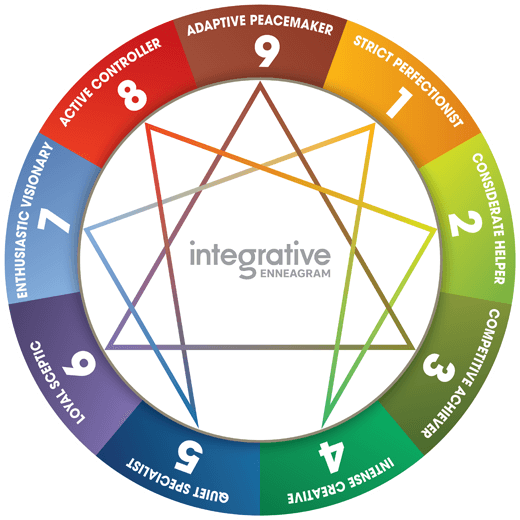The Enneagram
A Tool for Leadership and Development
COMMUNICATION SKILLS · LEADING OTHERS · TEAM BUILDING · EMOTIONAL INTELLIGENCE · INTERPERSONAL RELATIONS · PERSONAL GROWTH · MANAGING CONFLICT

The Enneagram: The Enneagram is a dynamic, intricate system of nine personality types. It was popularized in the West during the early 1970s and has evolved into a structured system used by organizations such as Boeing, Google, Microsoft, and the Stanford Master of Business Administration (MBA) program. For those who want to sustain a deeper development path for themselves and for others, the Enneagram offers versatility and complexity useful for long-term learning and growth for business and personal benefits.
AN OVERVIEW OF THE 9 ENNEAGRAM TYPES*
Type One: The Strict Perfectionist
Overview: Ones create order and clarity, and they institute and enforce needed policies and procedures. Because of their high integrity and assuredness, followers usually trust Ones and believe they will be led in the right direction. Under stress, they can become rigid, emotionally unavailable, and highly critical.
*Tip: See mistakes as opportunities for improvement and find time to relax during the day.
Type Two: The Considerate Helper
Overview: Two leaders focus on the developmental needs of the team, helping others to develop their skills and abilities to advance in their careers. Their upbeat disposition makes it easy for their team to feel high levels of trust – a foundational asset for productivity. Under stress, they may become intrusive, resentful, and play favorites.
*Tip: Recognize that time alone for self-care will elevate your ability to lead more effectively and connect with others.
Type Three: The Competitive Achiever
Overview: Three leaders inspire others by consistently setting an example of high performance and excellence.They attract followership because they are typically likeable, charming and charismatic. As the consummate pacesetter, their high expectations of others could overwhelm their team.
*Tip: Take time out to celebrate achievements of the team before setting the next goal.
Type Four: The Intense Creative
Overview: Fours leaders are visionaries, creative in their approach towards work and life. They have a heightened ability to see the individuality and creativity in members of their team. Thinking outside-the-box, innovation and ideation are where they shine. Their need to be unique may become impractical. If not understood, fours may withdraw from others and become isolated.
*Tip: See how your role fits within the whole of the organization; this will make you a greater team player.
Type Five: The Quiet Specialist
Overview: Fives are observant, logical and generally reserved. Five leaders are highly analytical and able to develop a plan for getting from current reality to identified vision. They have the capacity to analyze their environment quickly and synthesize their observations into the big picture. They see things that others don’t and thrive left alone to analyze and solve problems.
*Tip: Be mindful on being detached from the team. Take time to connect 1:1 with team members on a regular basis.
Type Six: The Loyal Sceptic
Overview: Sixes leaders are careful, responsible and protective of the welfare of the group. They focus on maintaining consistency, tradition and cohesion. They are determined to perform their duty, to do what is best for the group, and provide for the needs of others. Under stress, they may become suspicious of what could go wrong rather than anticipating what could go right.
*Tip: Filter how much you express about pitfalls to avoid being seen as negative.
Type Seven: The Enthusiastic Visionary
Overview: Seven leaders inspire others with their upbeat, enthusiastic, and optimistic nature. They excel at generating excitement around a concept, product, event, etc… They focus on possibilities and options and keeping others entertained. To keep the excitement going, sevens may become impractical and distracted.
*Tip: Take time to strategize before embarking on a new project for the team.
Type Eight: The Active Controller
Overview: Eights are action-oriented self-starters who prefer to be in charge. They focus on getting things done and overcoming obstacles that may lie in their way. They bring great passion and determination to their team, and love a good challenge. Under stress, they can get arrogant, hostile and demanding without realizing the damage left behind.
*Tip: Let your guard down a little by sharing something personal (within reason) with your team.
Type Nine: The Adaptive Peacemaker
Overview: Nines are calm, pleasant, and charming. As leaders, they are resilient under change and challenges. They can make people feel safe and have a calming, anxiety-reducing effect on others. Democratic leadership is an inherent style of the Nine leader; When overused, it can be difficult making executive decisions or addressing conflict.
*Tip: Don’t always rely on consensus before making a decision, particularly when there is a problem or issue among the team.
*Based on the work of Mario Sikora and Robert Tallon.
